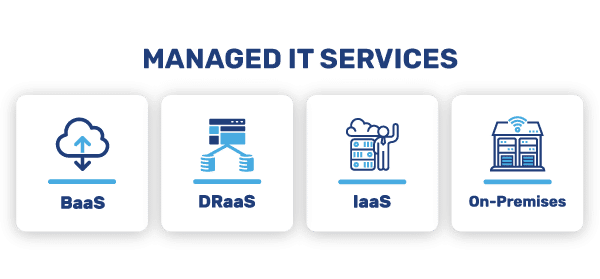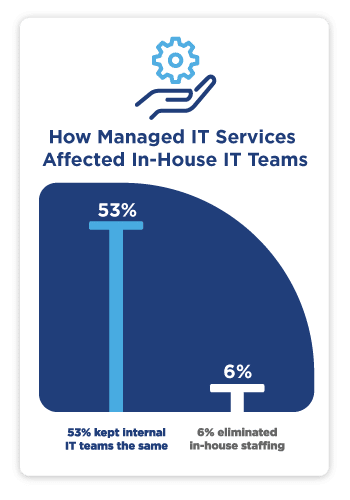What It’s Like to Work with a Managed IT Service Provider
Managed IT service providers partner with companies to provide IT services that enable them to manage their environment better.
Technologies such as data backup, disaster recovery and infrastructure can all be shifted to service-based technology offerings under this model. These as-a-service offerings reduce daily maintenance required with traditional IT purchase models moving companies toward a subscription-based IT model with a predictable monthly cost.

Time, expertise and cost are deciding factors in setting up an IT environment. As the commitment to daily management increases, managed IT services offer a beneficial alternative to in-house teams owning and maintaining IT infrastructure because they act as a quarterback to your team. Managed IT service providers offer services and solutions in the form of cloud-based storage, backup, disaster recovery, system security and infrastructure—along with all of the niche cloud services that fall underneath these umbrella terms.
This article introduces the services that make up managed IT and the reasoning behind why in-house teams are tapping IT service providers to manage their technology environments.
What Do Managed IT Service Providers Do?
In a nutshell, managed IT services are the anything-as-a-service (XaaS) of the IT world. This can be everything from cloud-based storage to colocation services to on-premises management of your technology. Four broad service areas that comprise managed IT services are:
- Backup as a Service (BaaS) — BaaS automates data backup by using cloud solutions maintained by a technology service provider, instead of owned backup solutions maintained by in-house teams, for example.
- Disaster Recovery as a Service (DRaaS) — DRaaS ensures businesses are up and running in the face of a disaster because it replicates business data in an off-site location in case the primary location becomes damaged.
- Infrastructure as a Service (IaaS) — IaaS alleviates the mundane routine of managing IT infrastructure in-house by using an IT service provider to rent hardware and software at a scalable opex.
- On-Premises Managed IT — This option provides organizations that need to keep all or some of their infrastructure on site a way to get help with management of the environment.

It’s common for companies to start with DRaaS or BaaS to get acquainted with as-a-service offerings before expanding to the many complementary services within managed IT. The main driver in adopting the above services is they free up in-house resources to focus on business innovation instead of daily maintenance.
Use of Managed IT Services Is Expanding. Why?
The use of managed IT services has grown significantly, particularly in the cloud area. In fact, Markets and Markets projects the cloud managed services market size to grow from $62.4 billion in 2020 to $116.2 billion by 2025. Not sure if you’re ready to jump in? Let’s lay out the benefits of managed IT services…
 Support remote employees. With today’s mobile, remote workforce, your end users will expect that you can support them in any way necessary. Wouldn’t it be nice to offer your employees full IT support wherever they are? IT solutions companies can offer remote monitoring and management (RMM), complete with 24x7x365 support, no downtime, up-to-date cyber security, and constant monitoring of your network’s health.
Support remote employees. With today’s mobile, remote workforce, your end users will expect that you can support them in any way necessary. Wouldn’t it be nice to offer your employees full IT support wherever they are? IT solutions companies can offer remote monitoring and management (RMM), complete with 24x7x365 support, no downtime, up-to-date cyber security, and constant monitoring of your network’s health.
 Access to best-in-class technology. Managed service providers can lift the burden of constantly playing catch-up with the latest IT. Most companies can’t afford top-of-the-line infrastructure, but partnering with a technology solutions provider means your data is hosted on secure, best-in-class technology that’s continually updated.
Access to best-in-class technology. Managed service providers can lift the burden of constantly playing catch-up with the latest IT. Most companies can’t afford top-of-the-line infrastructure, but partnering with a technology solutions provider means your data is hosted on secure, best-in-class technology that’s continually updated.
 Cost savings, three ways. The numbers don’t lie. Managed IT Services are better for your bottom line because of streamlined labor costs, optimal uptime, and predictable monthly costs.
Cost savings, three ways. The numbers don’t lie. Managed IT Services are better for your bottom line because of streamlined labor costs, optimal uptime, and predictable monthly costs.
 Offload your worries. Stop worrying about your IT team’s daily performance. Stop worrying about the speed, flexibility, and strength of your IT infrastructure. Managed IT service providers help clear a pathway to data protection for businesses.
Offload your worries. Stop worrying about your IT team’s daily performance. Stop worrying about the speed, flexibility, and strength of your IT infrastructure. Managed IT service providers help clear a pathway to data protection for businesses.
 Let the innovation begin! By outsourcing daily helpdesk, infrastructure, maintenance and/or data management, internal staff are free to focus on higher-level business initiatives and strategic goals. Put those brains to work and give them an actual challenge! Offering meaningful work and challenging opportunities is also a great strategy for attracting and retaining the best talent to your IT team.
Let the innovation begin! By outsourcing daily helpdesk, infrastructure, maintenance and/or data management, internal staff are free to focus on higher-level business initiatives and strategic goals. Put those brains to work and give them an actual challenge! Offering meaningful work and challenging opportunities is also a great strategy for attracting and retaining the best talent to your IT team.
How Does Our Existing IT Team Work with Managed IT Services?
We know, outsourcing has toxic connotations. You may worry about how hiring a managed
 service provider will affect your team and their workload. Will you have to let your team go?
service provider will affect your team and their workload. Will you have to let your team go?
No.
In most cases, organizations keep their internal IT department intact and unchanged. According to CompTIA, only 6 percent of organizations that implemented managed IT services got rid of their internal IT team. The majority of businesses kept their IT team headcount exactly the same.
By implementing managed IT services, your team can experience less time spent on routine maintenance, increased headspace to focus on innovation for the company, and more support for end users. The increased efficiency and flexibility that comes with managed IT services means your tech stack is ready to support your business needs, no matter what.
In fact companies like ComportSecure have an offer to extend your team in house or work with our experts in the field.
Get started by contacting ComportSecure’s managed services team today.



























